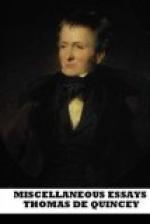Recurring, however, for one moment to classical antiquity, I cannot but think that Catiline, Clodius, and some of that coterie, would have made first-rate artists; and it is on all accounts to be regretted, that the priggism of Cicero robbed his country of the only chance she had for distinction in this line. As the subject of a murder, no person could have answered better than himself. Lord! how he would have howled with panic, if he had heard Cethegus under his bed. It would have been truly diverting to have listened to him; and satisfied I am, gentlemen, that he would have preferred the utile of creeping into a closet, or even into a cloaca, to the honestum of facing the bold artist.
To come now to the dark ages—(by which we, that speak with precision, mean, par excellence, the tenth century, and the times immediately before and after)—these ages ought naturally to be favorable to the art of murder, as they were to church architecture, to stained glass, &c.; and, accordingly, about the latter end of this period, there arose a great character in our art, I mean the Old Man of the Mountains. He was a shining light, indeed, and I need not tell you, that the very word “assassin” is deduced from him. So keen an amateur was he, that on one occasion, when his own life was attempted by a favorite assassin, he was so much pleased with the talent shown, that notwithstanding the failure of the artist, he created him a duke upon the spot, with remainder to the female line, and settled a pension on him for three lives. Assassination is a branch of the art which demands a separate notice; and I shall devote an entire lecture to it. Meantime, I shall only observe how odd it is, that this branch of the art has flourished by fits. It never rains, but it pours. Our own age can boast of some fine specimens; and, about two centuries ago, there was a most brilliant constellation of murders in this class. I need hardly say, that I allude especially to those five splendid works,—the assassinations of William I, of Orange, of Henry IV., of France, of the Duke of Buckingham, (which you will find excellently described in the letters published by Mr. Ellis, of the British Museum,) of Gustavus Adolphus, and of Wallenstein. The King of Sweden’s assassination, by the by, is doubted by many writers, Harte amongst others; but they are wrong. He was murdered; and I consider his murder unique in its excellence; for he was murdered at noon-day, and on the field of battle,—a feature of original conception, which occurs in no other work of art that I remember. Indeed, all of these assassinations may be studied with profit by the advanced connoisseur. They are all of them exemplaria, of which one may say,—
Nociurna versata manu, versate diurne;
Especially nocturna.




